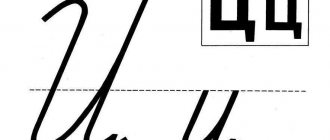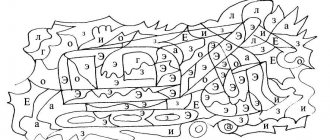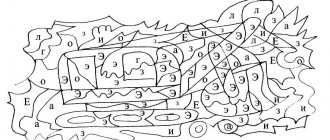What to do at the differentiation stage
At the differentiation stage, correction of parasigmatisms is carried out. The speech therapist or parents offer tasks for phonemic processes. An adult must pronounce sounds clearly and emphasize them strongly with his voice. This is due to the fact that if the child pronounced the mixed sound incorrectly, then he heard the phoneme distorted.
If it is difficult for him to identify the desired phoneme by ear, offer to repeat it after an adult. Gradually, the baby will learn to complete the task by ear. Offer to find a phoneme in syllables and words. Pay attention to articulation, especially if you rely on pronunciation when performing exercises.
Work on the sound analysis of the word. Explain to your child where the beginning, middle and end of the word are, what sounds are called consonants and vowels. Be sure to characterize C, practice identifying the place of the phoneme in syllables. Then start working with words.
Invite your child to divide the pictures into groups with certain phonemes. First choose phonemes that are completely different in acoustic and articulatory characteristics. Then, when you reinforce the correct pronunciation of words, include phonemes from the same group (C and C) in your lessons.
Carry out correction work gradually; there is no need to burden the baby with a lot of information. It is step-by-step that is an important component of successful training.
Speech diagnostics
To determine the cause of the violation of sound pronunciation, it is necessary to make a diagnosis of speech development. The speech therapist begins his work by examining the articulatory apparatus: appearance, motor skills. To do this, he asks the child to perform exercises to maintain the desired posture - in the case of a whistling group of sounds, they practice the lower position of the tongue, holding it behind the teeth, and dynamic tasks that help assess the mobility of the lips and tongue. First, the speech therapist shows the exercise, then asks the child to repeat it.
Speech therapy diagnostics includes tasks to assess speech breathing. The specialist pays attention to how the child inhales and exhales, and whether his diaphragm is working. To assess the force of exhalation, you can offer to blow away a light object or play the pipe.
Speech material must be selected not only from C, but also from C and T, because production of a given sound can only begin if the child pronounces the reference phonemes correctly.
The child repeats all tasks for naming syllables and words after the adult. It's the same with phrases and sentences. All instructions must be clear and the adult's pronunciation must be clear.
And in tasks for coherent speech, the speech therapist asks the child to compose a short story based on the picture or tell something about a subject that is close to him. You need to select the material so that one word and sentence does not contain C, S and T at once.
Then the child is offered tasks to identify the desired sound among others. Then the speech therapist shows him pictures and asks him to name words that contain C. Before completing the sound analysis task, the adult explains to the child what the beginning of a word, the middle and the end are. Then he says a word and asks to determine where the sound is.
In addition to speech diagnostics, the speech therapist must communicate with parents. This is necessary not only to advise them on all important issues and explain the corrective work plan. So the specialist will also determine in what speech environment the child is being brought up and whether it is necessary to carry out work in this direction.
Exercises to develop articulatory motor skills and speech breathing
Before staging the sound, it is necessary to prepare the organs of articulation to form the desired structure by doing gymnastics. They need to be selected taking into account the pronunciation of reference sounds. In the case of C, these are T, S. But the exercises for developing the correct structure for these phonemes are almost the same as for C. If it is difficult for a child to keep his lips in a smiling position, then you need to practice this position.
You also need to normalize the muscle tone of the tongue; for this, purchase a set for speech therapy massage.
The child can spank it with his lips and lightly bite it. All exercises for the tongue should develop the ability to keep it down, and it should be wide and relaxed. Ask your baby to make his tongue look like a hill and fix it in this position.
In addition to tasks on maintaining a certain position, include tasks on dynamics in the complex. These are movements of the tongue up and down, to the sides, offer to brush their teeth and lick their lips. But in all exercises you need to train the lower position of the tongue in order to form the correct basis for the pronunciation of sibilants.
If a child has nasal sigmatism, then the complex of preparatory work must include tasks for the formation of correct speech breathing and a strong air stream. You can first learn to inhale through your nose and exhale through your mouth while lying down. Be sure to focus on the work of the diaphragm, place the child’s hand on this area.
To practice strong exhalation, invite your child to play the pipe or play the game “Who will blow out the cotton wool or feather next.” You can perform breathing exercises by placing your wide tongue on your lower lip, so you will not only train the force of exhalation, but also the lower position of the tongue.
Duration and tips for organizing correctional work
The duration of therapy depends on the speech disorder and how parents responsibly approach speech therapy sessions. Their number should be at least 3-4 times a week. Their duration depends on the age of the child. Be sure to use visual material.
It's okay if automation takes longer in syllables and words. Often, consolidation in coherent speech occurs faster because the child has mastered correct articulation. But you only need to automate clear sound without distortion.
For correctional work to be effective, you may need the help of other specialists, especially if the child has a complex speech disorder. This is a defectologist, a neurologist, because in this case it is necessary to provide a complex impact.
Features of articulation
Normally, when pronouncing C, the lips are in the position of a slight smile, the teeth are visible. They are slightly closer together, there should be a small gap between them. The tip of the tongue should be made wide and placed in the lower oral cavity. And its side edges touch the upper teeth.
Feature of the articulation of the sound C - the front part of the tongue should take a position for several seconds as for pronouncing T. In this position, together with the alveoli, the tongue forms a gap, and when exhaling, the stream turns out to be strong, cold, as when pronouncing S. Pay the child’s attention to the peculiarity of the exhaled stream: it not just directional, but jerk-like. When pronouncing this phoneme, a person pushes out air. The vocal cords are open and do not work, so the sound C is a dull consonant.










